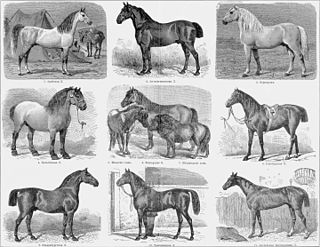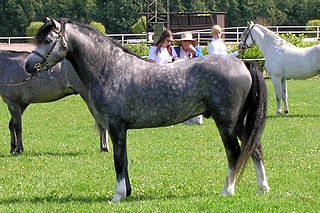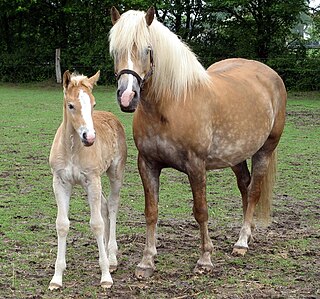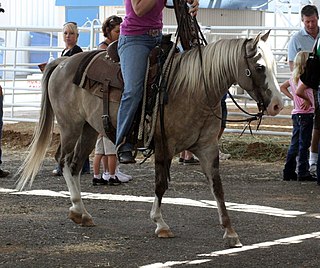
A horse breed is a selectively bred population of domesticated horses, often with pedigrees recorded in a breed registry. However, the term is sometimes used in a broader sense to define landrace animals of a common phenotype located within a limited geographic region, or even feral "breeds" that are naturally selected. Depending on definition, hundreds of "breeds" exist today, developed for many different uses. Horse breeds are loosely divided into three categories based on general temperament: spirited "hot bloods" with speed and endurance; "cold bloods," such as draft horses and some ponies, suitable for slow, heavy work; and "warmbloods," developed from crosses between hot bloods and cold bloods, often focusing on creating breeds for specific riding purposes, particularly in Europe.

The Icelandic horse is a breed of horse developed in Iceland. Although the horses are small, at times pony-sized, most registries for the Icelandic refer to it as a horse. Icelandic horses are long-lived and hardy. In their native country they have few diseases; Icelandic law prevents horses from being imported into the country and exported animals are not allowed to return. In addition to the gaits of walk, trot, and canter/gallop typical of other horse breeds, many Icelandic horses can also do the tölt and the flying pace. The only breed of horse in Iceland, they are also popular internationally, and sizable populations exist in Europe and North America. The breed is still used for traditional sheepherding work in its native country, as well as for leisure, showing, and racing.

The Morgan horse is one of the earliest horse breeds developed in the United States. Tracing back to the foundation sire Figure, later named Justin Morgan after his best-known owner, as well as mares of the now-extinct Narragansett Pacer breed, Morgans served many roles in 19th-century American history, being used as coach horses and for harness racing, as general riding animals, and as cavalry horses during the American Civil War on both sides of the conflict. Morgans have influenced other major American breeds, including the American Quarter Horse, the American Saddlebred, the Tennessee Walking Horse, and the Standardbred.

The Percheron is a breed of draft horse that originated in the Huisne river valley in western France, part of the former Perche province, from which the breed takes its name. Usually gray or black in color, Percherons are well-muscled, and known for their intelligence and willingness to work. Although their exact origins are unknown, the ancestors of the breed were present in the valley by the 17th century. They are believed to descend from war horses. Over time, they began to be used for pulling stagecoaches; and later, for agriculture and hauling heavy goods. In the late 18th and early 19th centuries, Arabian blood was added to the breed. Exports of Percherons from France rose exponentially in the late 19th century, and the first purely Percheron stud book was created in France in 1893.
Riding pony is a horse show classification used to refer to certain types of ponies. Competition is divided into sections based on height and type, and include being judged under saddle in standard pleasure horse classes, as well as in related events such as sidesaddle or in-hand.

The Pony of the Americas is a pony breed developed in the state of Iowa in the United States. The foundation stallion was an Arabian/Appaloosa/Shetland pony cross. A breed registry was founded in 1954, and within 15 years had registered 12,500 ponies. Today, the Pony of the Americas Club is one of the largest and most active youth-oriented horse breed registries in the US. Although called ponies, POAs have the phenotype of a small horse, combining mainly Arabian and American Quarter Horse attributes. The registry is open, allowing blood from many other breeds, but has strict criteria for entry, including Appaloosa coloration, specified height and other physical characteristics. Although mainly bred for Western riding, the breed has been used for many other disciplines, including driving, endurance riding and some English disciplines.

The Quarab is a horse breed from the United States, developed from a part-Arabian cross of Arabian horses, American Quarter Horses and Paint horses. Members of the breed are found that resemble all three of the foundation breeds, leading to three recognized types: Straight or Foundation, Stock and Pleasure. Although there have been records of crosses between the three breeds throughout the history of their respective registries, the first Quarab registry was formed in 1984, but later went out of business. In 1999, the International Quarab Horse Association was formed and remains the leading force in Quarab breeding. In order to be registered with the IQHA, horses must have at least 1/8 blood from both the Arabian and stock horse types.

The Dole Gudbrandsdal, Dølahest, or Dole is a draft- and harness-type horse from Norway. The Dole Trotter is alternately considered a subtype of the Dole Gudbrandsdal and a separate breed; it is also considered a part of the coldblood trotter type. The Dole Gudbrandsdal is a small draft horse, known for its pulling power and agility, while the Dole Trotter is a smaller, faster horse used for harness racing; the two types are commonly interbred. Both types are strictly critiqued before entry into the studbook, which has over time resulted in an improvement in the breed type. The Dole is originally from the Gudbrandsdal Valley, and is probably descended in part from the Friesian horse. Over time, the breed has had Thoroughbred, Arabian, and other breeds added in, especially during the creation of the Dole Trotter in the 19th century. The first studbook was created in 1941, and the current breed association was formed in 1947. Although originally used mainly as a pack horse, today, the heavier Dole type is used mainly for agricultural purposes. The Dole Gudbrandsdal been crossed with other breeds to develop horses for harness racing and riding.

The Welsh Pony and Cob is a group of four closely-related horse breeds including both pony and cob types, which originated in Wales. The four sections within the breed society for the Welsh breeds are primarily distinguished by height, and also by variations in type: the smallest Welsh Mountain Pony ; the slightly taller but refined Welsh Pony of riding type popular as a children's show mount; the small but stocky Welsh Pony of Cob Type, popular for riding and competitive driving; and the tallest, the Welsh Cob, which can be ridden by adults. Welsh ponies and cobs in all sections are known for their good temperament, hardiness, and free-moving gaits.
The Welara is a part-Arabian pony breed developed from the Arabian horse and the Welsh pony. It was originally bred in England by Lady Wentworth at the Crabbet Arabian Stud in the early 1900s from imported Arabian stallions and Welsh pony mares. Breeding then spread throughout North America. In 1981, a breed registry was formed in the United States, and a studbook began to be published. They are used for many disciplines of English riding, and are known for their refinement, hardiness and spirit.

The Haflinger, also known as the Avelignese, is a breed of horse developed in Austria and northern Italy during the late 19th century. Haflinger horses are relatively small, are always chestnut with flaxen mane and tail, have distinctive gaits described as energetic but smooth, and are well-muscled yet elegant. The breed traces its ancestry to the Middle Ages; several theories for its origin exist. Haflingers, developed for use in mountainous terrain, are known for their hardiness. Their current conformation and appearance are the result of infusions of bloodlines from Arabian and various European breeds into the original native Tyrolean ponies. The foundation sire, 249 Folie, was born in 1874; by 1904, the first breeders' cooperative was formed. All Haflingers can trace their lineage back to Folie through one of seven bloodlines. World Wars I and II, as well as the Great Depression, had a detrimental effect on the breed, and lower-quality animals were used at times to save the breed from extinction. During World War II, breeders focused on horses that were shorter and more draft-like, favored by the military for use as packhorses. The emphasis after the war shifted toward animals of increased refinement and height.
The Colorado Ranger is a horse breed from the Colorado High Plains in the United States. The breed is descended from two stallions imported from Turkey to the US state of Virginia in the late 1800s. These stallions were then bred to ranch horses in Nebraska and Colorado, and in the early 1900s the two stallions who every registered Colorado Ranger traces to, Patches #1 and Max #2, were foaled. The breed was championed by rancher Mike Ruby, who founded the Colorado Ranger Horse Association in 1935. Original registry membership limits resulted in many Colorado Ranger horses being registered instead as Appaloosas, but pedigree research is ongoing to discover additional horses who trace their ancestry back to the original stallions.
The Virginia Highlander is a small breed of horse with a four-beat ambling gait. It stands between 13 and 14 hands high. Coat colors include roan, chestnut, black and gray, and the occasional white. Breed characteristics include a good temperament and a natural singlefoot gait.

The Deutsche Reitpony or German Riding Pony is a very popular pony breed in Germany. It is described as a "miniature warmblood" with refined, horse-like characteristics that make it suitable as both a children's pony and as a mount for sport horse competition in Europe. Originally bred in Germany and later throughout Western Europe, the breed is relatively new to North America.
The Czechoslovakian Small Riding Pony is a breed of pony, used as a riding animal for children.

The Heck horse is a horse breed that is claimed to resemble the tarpan, an extinct wild equine. The breed was created by the German zoologist brothers Heinz Heck and Lutz Heck in an attempt to breed back the tarpan. Although unsuccessful at creating a genetic copy of the extinct species, they developed a breed with grullo coloration and primitive markings. Heck horses were subsequently exported to the United States, where a breed association was created in the 1960s.

The Quarter Pony is a breed of pony that is similar to the American Quarter Horse. It stands up to 14.2 hands high and was developed from American Quarter Horse foundation bloodstock. The breed was originally developed from Quarter Horses that did not meet the American Quarter Horse Association's height requirement. It is bred to look like a small Quarter Horse, although the various registries also allow crosses with other breeds, including Paint horse, Appaloosa and Pony of the Americas, all stock types. It is one of the most versatile horse breeds there are. There are three registries for the Quarter Pony, all with slightly different registration requirements. The first registry was begun in 1964, and two more were started in the 1970s. The breed is used today in a variety of Western and English riding disciplines.

The Pintabian horse is an American part-Arabian horse breed. It has over 99% Arabian blood, but also exhibits the tobiano color pattern, which is not found in thoroughbred Arabians. The registry began using the term "Pintabian" in 1992 and trademarked the word in 1995. which is the official registering authority for Pintabian horses worldwide.

A part-Arabian, partbred Arabian or, less precisely, half-Arabian, is a horse with documented amounts of Arabian horse breeding but not a purebred. Because the Arabian is deemed to be a breed of purebred horse dating back many centuries, the modern breed registries recognized by the World Arabian Horse Organization generally have tightly closed stud books which exclude a horse from registration if it is found to contain any outside blood. However, Arabian breeding has also been used for centuries to add useful traits to countless other horse breeds. In the modern era, crossbreeding has been popular to combine the best traits of two different breeds, such as color, size, or ability to specialize in a particular equestrian discipline.














